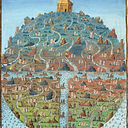Deleuze on Morphology and the Assemblage
What follows is a long extract from Dialogues by Deleuze and Claire Parnet.

“What must be compared in each case are the movements of deterritorialization and the processes of reterritorialization which appear in an assemblage. But what do they mean, these words which Félix invents to make them into variable coefficients? We could go back to the commonplaces of the evolution of humanity: man, deterritorialized animal. When they say o us that the hominoid removed its front paws from the earth and that the hand is at first locomotor, then prehensile, these are the thresholds or the quanta of deterritorialization, but each time with a complementary reterritorialization: the locomotor hand as the deterritorialized paw is reterritorialized on the branches which it uses to pass from tree to tree; the prehensile hand as deterritorialized locomotion is reterritorialized on the torn-off, borrowed elements called tools that it will brandish or propel. But the ‘stick’ tool is itself a deterritorialized branch; and the great inventions of man imply a passage to the steppe as deterritorialized forest; at the same time man is reterritorialized on the steppe. The breast is said to be a mammary gland deterritorialized by vertical stature; and the mouth a deterritorialized animal mouth, by the turning-up of the mucous membranes to the exterior: but a correlative reterritorialization is carried out of the lips on to the breast and conversely, so that the bodies and the environments are traversed by very different speeds of deterritorialization, by differential speeds, whose complementarities form continuums of intensity, but also give rise to processes of reterritorialization. At the limit, it is it is the nomad, the man of the earth, the man of deterritorialization — although he is also the one who does not move, who also remains attached to the environment, desert or steppe. (Deleuze & Parnet, Dialogues II, p.134)
